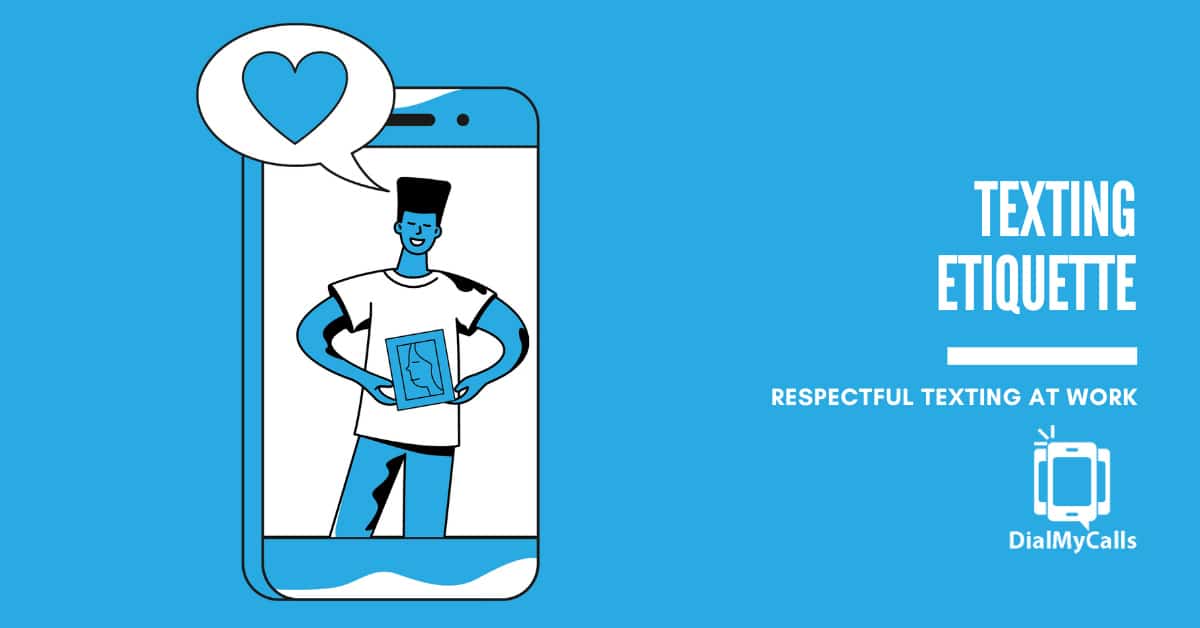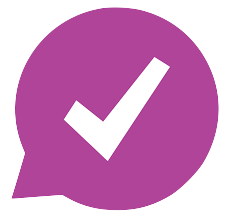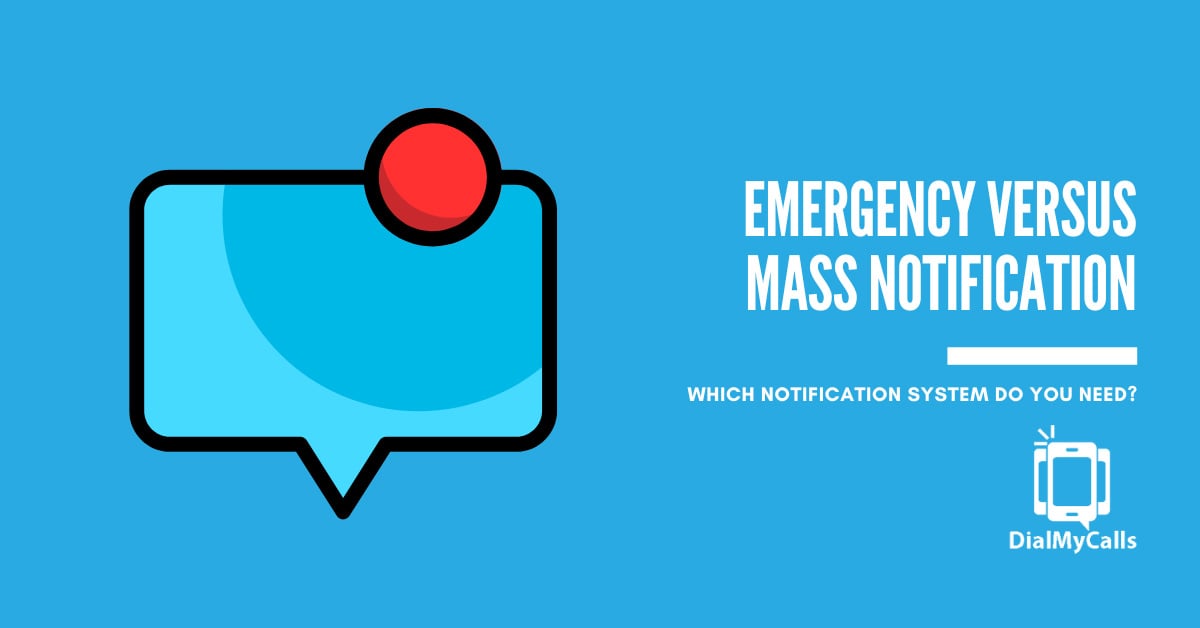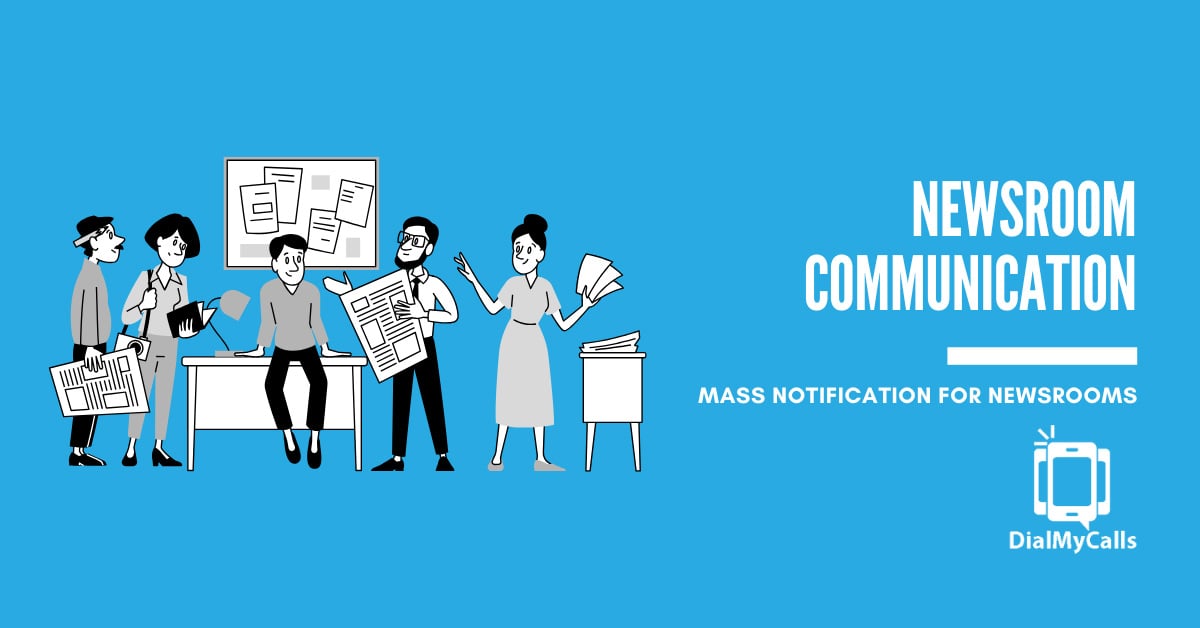Proper Texting Etiquette: Guidelines for Respectful Texting in the Workplace
Posted by Tim Smith in Mass Notification System on June 21, 2023
Updated on November 18, 2024

Texting has become ubiquitous in the business world. It’s a great way to communicate with customers and coworkers quickly and efficiently. However, some basic etiquette rules should be followed when texting to maintain professionalism and respect.
In this blog post, you’ll learn the texting etiquette guidelines for respectful texting, bad examples to avoid, and how DialMyCalls can help streamline the process.
What Is Good Texting Etiquette?
Proper texting etiquette follows a set of guidelines to ensure mutual respect between the sender and recipient. Its purpose is to cultivate stronger relationships between team members; it can also be used to strengthen customer relationships.
When asking yourself, “What is proper texting etiquette?” you should be concerned with how the recipient will feel when receiving the message.
What may appear normal when texting a friend or family member may not be appropriate for business settings. A professional workplace should follow a higher standard when answering the question, “What is text etiquette?”
A work text should make the recipient feel understood, respected, and appreciated. To this end, it is essential to be aware of your words’ impact on the person on the other end of your text message.
Examples of Bad Texting Etiquette
You or someone on your team may have been guilty of unintentionally bad texting etiquette. People at all levels of an organization need to be aware of what bad texting etiquette looks like and how it affects workplace culture.
Missed Appointments? Not Anymore
Use SMS & Phone Calls to Automatically Send Appointment Reminders
An example of bad texting behavior would be sending messages too quickly, which may appear demanding. Imagine you want to know the accounting team’s Q4 projections, so text the department head for an answer. After five minutes without a response, you send another text. You continue to spam text your colleague for the next 30 minutes only to find out they are in a meeting.
Another example of bad texting etiquette is sending a reminder text to a customer for an upcoming onboarding call but misspelling several words and using bad grammar. Text reminders about an upcoming appointment are helpful to 76% of consumers; still, a potential lead might no longer consider your business professional and look elsewhere if the text is riddled with errors.
The Importance of Professional Texting Etiquette
Professional texting etiquette helps foster communication and relationships with your team and customers. Good business texting etiquette aims to create healthier ways to communicate. It also makes it more likely that your customers will consider your customer service superior and your team members more effective.
Professional texting encourages clear and concise conversations, ensuring that information is relayed quickly and accurately without taking up too much time. This will help your customers get the information they need to feel comfortable with your products or services, and your team members will value talking with other departments because of the time saved.
A consistent approach to proper text message etiquette can also help businesses reduce errors due to miscommunication or misunderstanding. Departments that can text effectively will be more productive, and customers won’t have as many complaints about errors.
Both email and texting etiquette ensures that all team members know what is acceptable when it comes to communication, which promotes better collaboration across departments. It also helps managers communicate more effectively with their teams, allowing them to respond promptly and complete projects on time.
10 Guidelines for Respectful Texting:
Wanting to use respectful texting within your team and implementing the skill are two separate concepts. Below is a set of guidelines you can follow to start using good business etiquette through phone, email, and text as a team.
1. Use Correct Grammar
Correct grammar shows respect for the recipient and reinforces your credibility as an authority in your field. Using proper grammar in your texts demonstrates you care about the quality of your communications with your team and customers.
This will help to create an environment where team members and customers trust each other and trust in your organization. Similarly, writing in complete sentences shows that your business takes the time to express itself clearly, something most customers appreciate when engaging with companies.
Correct grammar also helps maintain clarity and accuracy when sending messages. By avoiding colloquialisms and abbreviations, messages remain easy to understand for everyone involved. This ensures there are no misunderstandings or confusion due to miscommunication. When your business text messages have correct grammar, you’ll develop more customer trust and deliver clear business messages.
2. Reply in a Timely Manner
Focusing on texting etiquette response time is imperative to creating a successful sales process. It’s been shown that businesses that respond to a lead in five minutes or less are 21x more likely to convert the lead.
Replying quickly sets customer expectations and creates an environment of trust and reliability. This will help to bolster your business’s reputation and keep people coming back for future interactions.
Not replying promptly can lead to confusion, frustration, or even anger from the recipient. Delayed responses can also make teams less efficient as communication practices become unreliable and projects take longer to complete.
Responding quickly to texts demonstrates respect for colleagues and customers alike, helps create an atmosphere of trustworthiness, and keeps teams working efficiently on projects.
3. Keep Communications Professional
A professional tone in all communications helps elevate the respect and dignity of your team. With professional communication, your team members and customers will start to look at the organization as an authority and trust its decisions.
Make sure that all texts are written in a clear, professional format, and avoid using slang or colloquialisms. Maintaining this tone of respect also helps to ensure customers feel comfortable engaging with your business and increases the likelihood of conversions.
An unprofessional text sent to customers or team members lowers the sender’s and the brand’s credibility. It will cause customers to lose faith in the organization and question their decision to use your product or service.
Establish text messaging etiquette rules for professional communication in your office. Send a mass email to your team to reinforce the texting tone you want to see made by your team to each other and your customers.
4. Keep Communications Short
Particularly in workplace settings, it’s essential to be concise to ensure messages are understood quickly. This helps to save time and increases productivity by making it easier for people to read and respond quickly. The average time it takes someone to respond to a message is 90 seconds, meaning they’ll wait for your response after they hit the send button.
As a manager, you should encourage your team to keep their messages short and precise. For instance, a business can set guidelines on how much information should be included in each message and requirements for response times.
Everyone in your organization — and everyone affected by your organization — will benefit from improved clarity and efficiency when using short text messaging etiquette. This helps create better working relationships, as misunderstandings are less likely when messages are straightforward.
5. Limit the Number of Messages Sent
Email and text etiquette in the workplace often involves being inundated with dozens of messages daily. Different departments, customers, managers, and colleagues all communicate through text, and the number of messages can quickly get out of hand.
Limit the number of texts sent daily or weekly to keep your team productive. Consider setting up specific days and times when people can send texts so everyone is on the same page about scheduling their responses.
This will help to reduce confusion and maintain efficiency by ensuring people aren’t over-texting and clogging up the lines of communication.
Your team also won’t lose any valuable information regarding your customers if messages are kept to a minimum. Having several phone notifications for multiple messages causes employees to become confused and forget what conversations they were focused on. Help keep them on track by limiting the number of messages sent for each thread.
6. Stick to Business Hours
Setting boundaries on times your business can text customers keeps your messaging from appearing as spam. Sending your clients messages during the night when they could be eating or sleeping is unprofessional and could cause them to unsubscribe from your communication and possibly stop using your product or service.
Let customers know when they can expect your response, and stick with that schedule. The same guideline should apply to your team. Texting coworkers that you need certain documents or files at midnight will throw off your team’s workflow and make them resentful. Employees won’t feel they have any purpose outside of work, and it will cause burnout.
Using texting hours etiquette in the workplace will help your customers and employees feel respected and appreciated.
7. Limit Text-Speak Jargon
Acronyms like LOL or BRB might be expected when texting friends, but they have little function in the workplace. For starters, not all employees may be familiar with the same type of text-speak jargon. While some people will be familiar with the acronyms, others will remain clueless. The same can be said about your customers.
A business should set guidelines on how and when text-speak jargon can be used, if at all. For instance, a company could provide its employees with a list of acceptable terms and phrases they can use to communicate with customers and team members. This ensures everyone knows what is appropriate for the workplace setting and helps ensure that customer queries are responded to accurately and effectively.
8. Only Use Symbols or Emojis When Necessary
Symbols and emojis can confuse customers who are not tech-savvy or familiar with the latest trends, meaning they could misinterpret these symbols and emojis as unprofessional.
As such, businesses should ensure their employees understand what types of symbols and emojis are acceptable in customer communication. Certain characters may have different meanings in different cultures, so it’s crucial to maintain a high level of cultural sensitivity when using them. Additionally, a business could create guidelines that dictate how many times and when certain symbols or emojis can be used.
Unless your brand appeals to kids, your professional text message etiquette should only use symbols and emojis when they are absolutely necessary. They can cloud the meaning of a message and distract from the overall goal.
9. Understand When the Conversation Is Over
Leaving a conversation open-ended can confuse customers or coworkers and even make them feel ignored or disrespected. For example, if a customer expects a response within a specific time frame and none is given, they may assume that their message has been overlooked.
A business should establish clear rules on how long employees should wait before replying to messages from customers or coworkers. For instance, if an employee takes more than 24 hours to respond, they should apologize for the delay to maintain good customer relations and professionalism. Businesses should also ensure that messages are closed by thanking customers for their inquiries or suggestions before ending the conversation.
Many customer service agents will end a conversation by asking if there is anything else they can do to help. This is a classic way companies can get customers to agree that the conversation has ended while leaving them with a good impression.
10. Stick to One Clear Purpose
Trying to tackle multiple topics in a single message can confuse customers or coworkers and make the conversation difficult to follow. For instance, if an employee mixes customer service requests with product inquiries in the same text, the recipient may not understand what is being asked of them or, even worse, become overwhelmed by the sheer amount of information provided.
To avoid this, your business should encourage employees to focus on one purpose per text message. They should be encouraged to provide concise and clear explanations and organize their messages into different sections for easy reading and comprehension. You could also create templates that employees can use when sending out messages that contain all relevant information that needs to be included in each message.
Companies that use text initiatives have communicated with customers 97% better than if they used other methods. Ensure your campaigns aren’t wasted by following the critical guidelines listed above.
Our Automated Texting Platform Simplifies Professional Communications
Hopefully, your company can generate hundreds of phone numbers to contact via text messaging. However, it can be challenging to maintain the same quality of professional text etiquette when sending out hundreds or even thousands of messages a day.
That’s why DialMyCalls created our automated texting platform that simplifies professional communications. Our platform allows businesses to create and send personalized messages with just a few clicks, a service that offers the following benefits.
Automated Replies
The quicker a company reaches out to a lead, the better its chance of converting that lead. That’s why having an automated reply to every text message you receive is critical to landing more clients.
DialMyCalls includes an automated text message reply for any messages your team receives during working hours. You can set up pre-written responses that naturally guide your leads to the next step in your sales process. You can also trigger automatic text replies in many situations, such as when someone clicks a link on your site or signs up for a survey. No lead will go unanswered, allowing your business to gain even more clients.
Personalized Responses
As long as your business gathers contact information on each lead, our automated texting platform allows you to send personalized messages.
You can personalize each message based on the lead’s name, company, location, or other information relevant to your business. Personalization allows for a more meaningful and direct connection with leads, significantly increasing the chances of conversion.
Spelling & Grammar Check
Instead of using manual labor to go through each mass text message, DialMyCalls gives you spelling and grammar tools to ensure each message is perfect.
This eliminates the need for proofreaders and reduces the time it takes to send an automated text. Ensure your messages are always polite, professional, and of course, free from any typos or miscommunication.
Contact us today for more information about how DialMyCalls can streamline your business texting.
Maximize Outreach, Save Time
Start Transforming Your Communication with Mass Texting
Author
Tim Smith is the Media Manager at DialMyCalls, where he has leveraged his expertise in telecommunications, SaaS, SEO optimization, technical writing, and mass communication systems since 2011. Tim is a seasoned professional with over 12 years at DialMyCalls and 15+ years of online writing experience.
Try Using DialMyCalls Right Now
Start For Free
Recent Posts
- How to Send Effective Shelter & Evacuation Text Alerts During Emergencies
- A Step-by-Step Guide to Building a Crisis Communication Playbook
- 6 Top Emergency Notification Challenges Schools Face and How to Solve Them
- 7 Best Practices for Tornado and Severe Storm Emergency Notifications
- 7 Best Practices for Church Emergency Notifications to Keep Congregations Safe
Categories
“I am a youth minister and have spent hours in the past calling students individually to remind them of an upcoming event or to get out an urgent announcement. With DialMyCalls.com, I cut that time down to about 1 minute. I also love how I can see exactly who answered live and how long they listened so I know if they heard the whole message. DialMyCalls.com is the best website I have stumbled upon all year! Thanks!”
Central Baptist Church
Try Using DialMyCalls Right Now
Start For Free
Author
Tim Smith is the Media Manager at DialMyCalls, where he has leveraged his expertise in telecommunications, SaaS, SEO optimization, technical writing, and mass communication systems since 2011. Tim is a seasoned professional with over 12 years at DialMyCalls and 15+ years of online writing experience.
Try Using DialMyCalls Right Now
Start For Free
Recent Posts
- How to Send Effective Shelter & Evacuation Text Alerts During Emergencies
- A Step-by-Step Guide to Building a Crisis Communication Playbook
- 6 Top Emergency Notification Challenges Schools Face and How to Solve Them
- 7 Best Practices for Tornado and Severe Storm Emergency Notifications
- 7 Best Practices for Church Emergency Notifications to Keep Congregations Safe
Categories
“I am a youth minister and have spent hours in the past calling students individually to remind them of an upcoming event or to get out an urgent announcement. With DialMyCalls.com, I cut that time down to about 1 minute. I also love how I can see exactly who answered live and how long they listened so I know if they heard the whole message. DialMyCalls.com is the best website I have stumbled upon all year! Thanks!”
Central Baptist Church
Try Using DialMyCalls Right Now
Start For Free




![What Is Conversational AI in SMS & Calling? [+ Real-World Applications]](https://www.dialmycalls.com/wp-content/uploads/2025/06/conversational-ai-in-sms-and-calling.jpg)